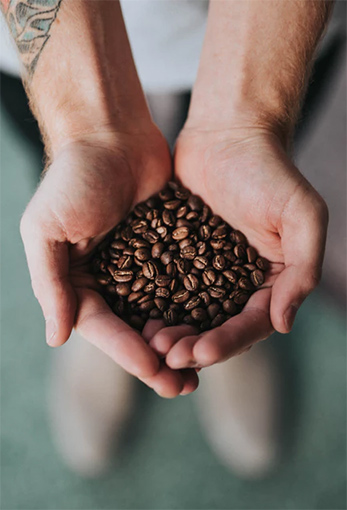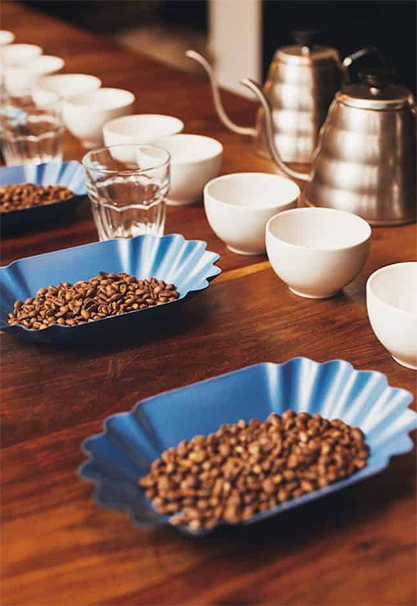From which stages does the coffee pass until it ends up in our cup?

Often, enjoying a cup of espresso or a hot cup of coffee, we ignore the process that preceded it, without even imagining the stages of the coffee bean until it reaches our cup.
Coffee cultivation and processing is an extremely laborious process that requires a lot of working hands, high expertise and persistent attention to detail in order to have the desired results. We summed up the course of coffee in 10 stages, once a coffee tree is planted until we hit our machine button. The adventures of the magical grain are sure to make us appreciate our espresso a bit more!
The adventures of coffee in ten stages
Cultivation: Coffee seeds are planted in shady places, often under other crops or tall trees. Plants require frequent watering, humid weather, and shady conditions, while the soil composition has a particular influence on the characteristics of the coffee. The coffee grows in nearly 50 African, Asian and Latin American countries that are found among the tropics of Cancer and Capricorn in the so-called "Coffee Belt."
 Harvesting: The coffee tree usually does 3-4 years to yield fruit. The cherry-like coffee fruit turns red when it is ready to be harvested, while it usually yields one crop in a year or in some countries, up to two. Depending on the soil morphology, harvesting can be done by hands or machinery. The cherries may be collected together or in some cases, one may be selected, based on parameters such as cure, color, absence of defects etc.
Harvesting: The coffee tree usually does 3-4 years to yield fruit. The cherry-like coffee fruit turns red when it is ready to be harvested, while it usually yields one crop in a year or in some countries, up to two. Depending on the soil morphology, harvesting can be done by hands or machinery. The cherries may be collected together or in some cases, one may be selected, based on parameters such as cure, color, absence of defects etc.
Processing: After harvesting, the coffee bean should be removed from the fruit, as the fruit will start to spoil if left. The separation of the bean from the flesh can be done either by the traditional method, where the coffee beans are dried in the sun and then the grain is removed, or by the wet method, whereby, after removing the outer casing, the granules mature in large tanks with water. In recent years, hybrid processing methods have emerged, combining elements from both previous methods.
Drying the beans: Whichever method has been used (and in particular the wet method) the grains contain moisture, which can spoil them. The moisture they contain should be limited to 11% in order to keep them until their roasting. Drying of grains can be done either traditionally, leaving them in the sun or in large special machinery.
Quality control: After removing the endocarp and any residual wrist and peel left over to the coffee bean, the beans are thoroughly checked and any defective ones are removed, and then sorted by size and quality. These procedures can be done mechanically, but usually manual work, though painful and more costly, has clearly better results.
Export: Green coffee (from the color of the uncooked grains) is packed in large sacks or, if large quantities, in plastic containers. The quantity of coffee produced is traditionally measured in sacks of 60kg.
 Tasting: Coffee is checked for both its quality and its flavor characteristics, with a process called cupping. Initially, the taster checks the quality of the green coffee, and then a small amount of it is carefully roasted, milled and the beverage is prepared by the pour over method. The cupper carefully notes the aromas of both hot and cold coffee, and finally tastes the drink, making sure it goes all over his palate. Coffee in this way is checked qualitatively, the characteristics are recorded, but also decisions are made regarding roasting and mixing. Cuppers often tastes dozens of samples a day, with the task of recording all the delicate differences.
Tasting: Coffee is checked for both its quality and its flavor characteristics, with a process called cupping. Initially, the taster checks the quality of the green coffee, and then a small amount of it is carefully roasted, milled and the beverage is prepared by the pour over method. The cupper carefully notes the aromas of both hot and cold coffee, and finally tastes the drink, making sure it goes all over his palate. Coffee in this way is checked qualitatively, the characteristics are recorded, but also decisions are made regarding roasting and mixing. Cuppers often tastes dozens of samples a day, with the task of recording all the delicate differences.
Roasting: The roasting process changes the green coffee to the beans that is suitable for preparing coffee. Roasting is done in special machines at high temperature and requires continuous grain movement, as well as specialized know-how in order for coffee to develop all its flavors to the maximum. Roasting, depending on the time and its effects on the bean, has different grades and different flavors. In general, roasting is done in the importing country and usually precedes blendig, although in some cases the grains may be mixed and roasted simultaneously.
Blending: Varieties are selected based on their flavor characteristics and blended by skilled workers, called blenders, to produce blends with the desired characteristics. Mixtures can contain coffees of different origins from a variety, or combine Arabica and Robusta. Whether a blend is meant for espresso, filter coffee or Greek coffee depends on both the varieties used and the degree of roasting. If the coffee is to be disposed of as a single origin one, blending is omitted.
Grinding & Packing: Coffee can be packaged in beans, so the consumer has to grind it, depending on its preferred extraction, or it can be ground and packaged in powder form. Usually, consumers prefer coffee in beans, as freshly ground coffee produces better results, regardless of the extraction we will use.
Brewing: After all these stages, the coffee is ready for use!
Our favorite coffee hides much more than we can imagine - thousands of people have to work with perseverance, effort and attention to make our espresso as the way we want it -to be the coffee we deserve.










